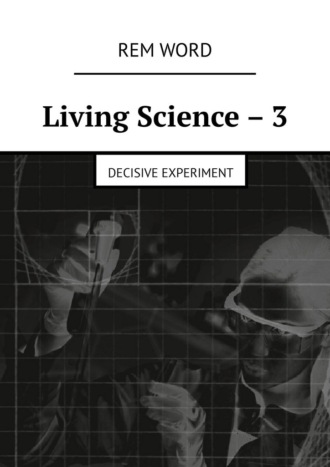
Полная версия
Living Science – 3. Decisive experiment
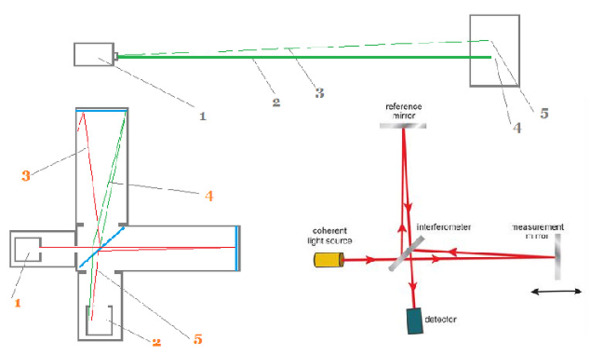
Figure above. The author’s experience with the deflection of a laser beam due to entrainment by the ether. 1. Laser (rigidly fixed, having a remote power source and switch, laser pointer). 2. Laser beam when turned on at 9 o’clock in the morning. 3. Beam when the laser is turned on at 17 o’clock. For clarity, the beam deflection angle is increased. 4. Place the beam mark on the screen at 9 o’clock in the morning. 5. Place of the beam mark at 17 o’clock. The screen and the laser are separated by a distance of 90 m. The difference between the positions of the light spot in the morning and in the evening (during five days of research) is 3 cm. 1. Light source 2. Detector (screen for observing the interference pattern). 3. Beam initially reflected perpendicular to the interferometer arm and deflected by the ether flow to the left. 4. A ray emitted towards the stream of ether, and therefore participating in the construction of an interference picture. 5. Beam reflected from the mirror of the interferometer arm, presumably directed along the flow. This ray is also bent by the ether.
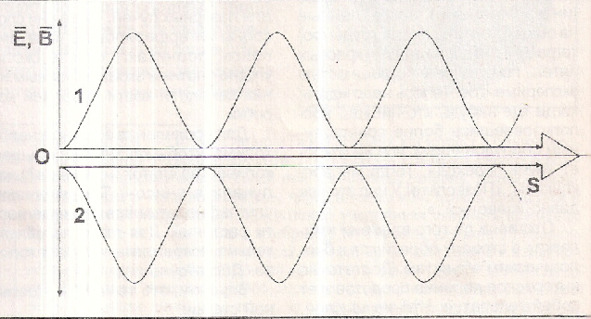
The light is in antiphase. Addition of vectors E and B in superposition
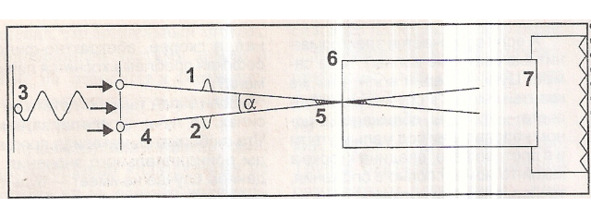
Installation for detecting hidden light. 1,2 – antiphase rays 3. source of coherent rays (laser) 4. phase shift device (diffraction grating) 5. beginning of the «black zone» 6. screen (foil) 7. light-sensitive material («Konica», 400 units).
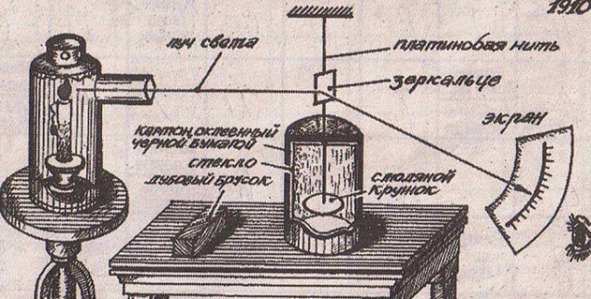
Professor Myshkin’s experiment
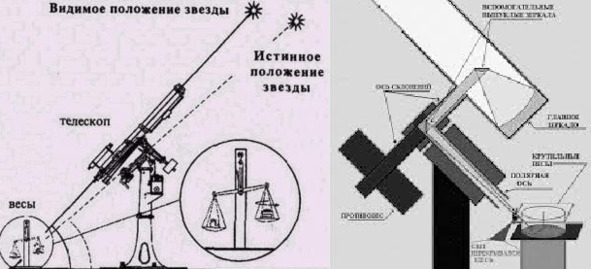
Kozyrev’s experience
The idea of one of the experiments to detect "hidden" light. Rays (waves) of coherent light, slightly displaced relative to each other by an interference grating, should fold in antiphase and disappear. In the "folded" form, they do not interact with matter. Therefore, having divided by themselves, the rays should appear behind the screens – which is interesting in itself. A diagram of the possible disappearance of rays is presented. Of the two components of the electromagnetic wave, vectors B and E, only one is shown.
The next figure is a diagram of the installation for obtaining "black rays" (for clarity, the convergence angle of the rays is greatly increased). The light that appeared behind the screen – aluminum foil, should have been fixed with photographic film for several hours. However, neither an increase in exposure nor a change in the length of the tube gave a positive result. An ambiguous result was shown by experiments with detectors from sheets of photographic paper folded together. In the course of this work, the feeling arose that the dark zones in the beam alignment were not formed by the addition of light waves. They appear due to the fact that the direction of the photons is determined by the interference grating itself. What is an interference grating? A set of identical stripes. The stripes lay out the light, even if the light is not coherent. They are like the strings of a grand piano, responding to each other's vibrations. Are they unique? Any mutually similar objects illuminated by a point source become synchronized. Note that the beams of individual lasers, equal in wavelength and amplitude, directed to one point, do not add up. There are no such cases. Perhaps the laser atoms themselves feel the presence of twin microparticles in another object, and do not send photons to where, having formed in antiphase, they could violate the law of conservation of energy.
A superluminal or pre-light quantum exists, obeys the ballistic law of addition of velocities, but it is rather difficult to weed out and register. “Catching” a superluminal signal with a conventional sensor is the same as trying to record X-rays with an electronic camera.
Let us turn to the article by V. Belyaev, published in "TM" No. 9, distant 1980. The author reproduces the experiments of Professor N. Myshkin (and also William Crookes), made at the beginning of the twentieth century. It turns out that the disk, suspended on a thin thread, for no apparent reason, periodically turns to one or another angle. These movements correlate with solar activity, the position of the moon, even when the scales are in the basement. As a first approximation, the torsion balance is the sensor for the hidden component of the light beam. In contrast to the semitransparent petal, which measures the pressure in the experiments of Academician P. Lebedev, our light recorder is a rather massive screen.
What else might sensors that are tuned to «hidden» light look like? Let us turn to the experiments of astrophysicist N. Kozyrev to determine the path of a star in the sky. Let’s discard the theory about the «influence of Time on physical processes», let’s leave the experiment. The academician directs the telescope to a distant star. A thermal resistor is located along the eyepiece axis. The change in the resistance of the sensor occurs not in a thin surface layer like a photocell, but throughout the entire volume. Therefore, the signal is recorded along the traversed path of the star. Option – already known to us torsion scales with a screen. This is how the detector detects «superluminal» and «pre-light» photons.
Energy returns. Is always
… How to return the energy dissolved in the bustle of microparticles? Probably, there are natural processes that increase its quality to its original value. Everything happens by itself. For clarity, a boiled kettle placed on the table gives energy to the table. it cools down. High-order energy is replaced by a uniform background. Is the reverse process possible? Will heat pulses be transmitted from the medium to the kettle? Will it boil for no apparent reason, on the kitchen table? The question is strange. But this should happen if there is a circulation of energy in nature from the beginning of time. One of the first publications of the author on the topic – an article in "TM", No. 4, 2000:
…«What is the difference between an object of the macrocosm – a monolith – from a cloud of dust obtained as a result of its long grinding and subsequent shaking? It is well known: the area of contact with the medium of another phase, for example, with a gas. That is why those chemical reactions take place in powders that do not affect monoliths at all – iron filings burn in the air, while an iron nail, perhaps in pure oxygen… But the question is – what happens when a monolith is ground or, conversely, sticking together dust back into a monolith with an emission-absorption spectrum? Let’s call on the laws of quantum physics to help. In a monolith, the spectrum runs through all energy levels, which, theoretically, are as many as there are atoms in the body. In a gas, however, individual atoms radiate independently, at several levels. But when atoms-neighbors appear, the levels shift so as not to repeat each other – the exclusion principle, introduced at the beginning of the 20th century, works. Wolfgang Pauli: there can be no interconnected atoms, the energy parameters of which are the same. But powder is an intermediate state between gas and solid. Apparently, it is impossible to draw a sharp boundary at which the properties change abruptly. And accordingly, the spectrum of the dust cloud, as the particles are fragmented, will approach the spectrum of the gas. But what happens if you thicken it to the volume of the original monolith? When, say, one hundred particles merge, each energy level will take one hundred atoms at once. To restore the order accepted in the microworld, each of such oversaturated levels will tend to split into a hundred isolated lines of the spectrum. The most natural way to restore the energy hierarchy for the atoms of the newly formed monolith is to emit a certain amount of electromagnetic quanta. Consequently, the thickened cloud of dust will generally become colder than the environment.

Our magic teapot
Aren't we humans the same hubs? Why are our cells not isolated "specks of dust" separated by membranes? But the membrane permeability is constantly changing. And are not many properties of living organisms that are not amenable to modern science associated with such a combination of many millions of "dust particles"? "
Continued in the article "Energy Concentrators", "TM" No. 6, 2002, based on the materials of experiments. Two vessels, one with a porous medium, the other with a solid one, are located in a thermostat. We measure the temperature of the internal environment every 20 minutes using sensors. It turns out that the temperature in the container with the granular medium (wet sand) changes abruptly. A continuous medium produces a flat temperature graph.
Granular matter has the ability to collect energy. The temperature in the anomalies rises by tens of degrees. By organizing matter, you can achieve a predictable release of heat in certain areas of it.
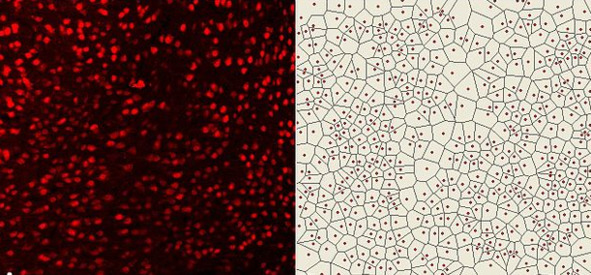
The collection and separation of dust particles of inanimate matter and the interaction of cell membranes, with the release of energy, are phenomena of the same level.
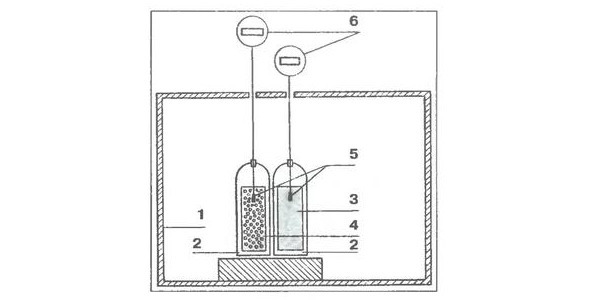
Experiment with granular and homogeneous media. 1. cabinet with thermal insulation 2. Dewar vessels 3. continuous medium (water) 4. porous medium 5. electronic thermometers. 6. temperature sensors.
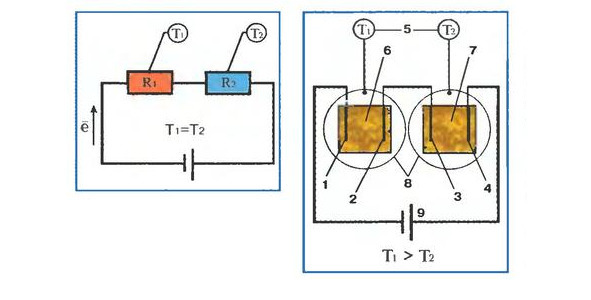
Experience with the passage of direct current through granular cells
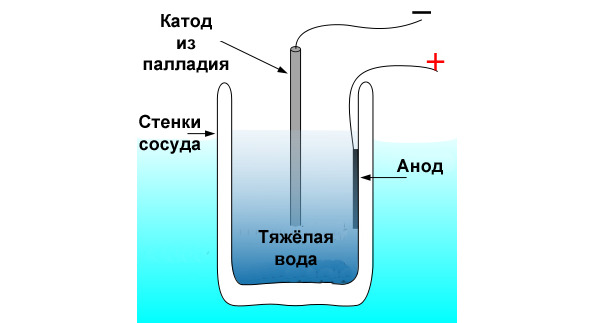
Fleischmann and Pons experience. The cathode, absorbing nuclei of hydrogen from heavy water, releases an abnormally large amount of energy

Experiments of Fleischmann and Pons in practice
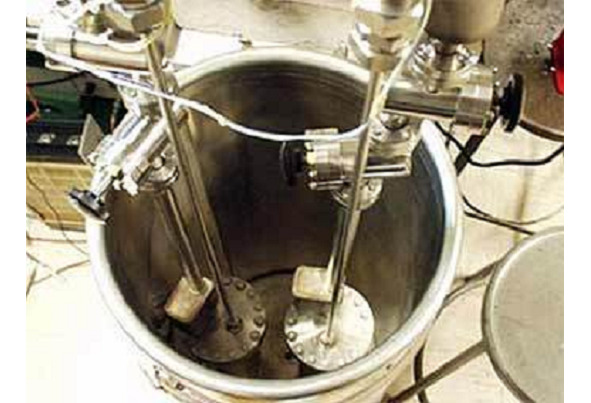
Cold fusion reactor from Japanese researchers. Osaka University. Palladium and zirconium oxide absorb deuterium. If gas bubbles also get into the mixture, the temperature of the heavy water reaches 70 degrees. Demonstration in front of reporters is successful. Scientists believe that heating is the result of nuclear fusion. However, if the water reached this temperature due to the fusion of nuclei, the radiation would kill those present.
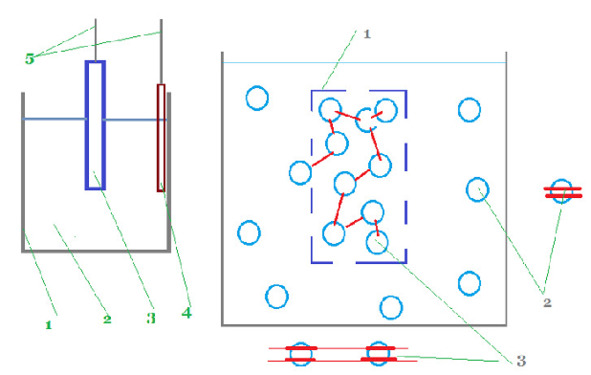
On the left is a diagram of the experiments of Fleischmann and Pons. 1.the walls of the vessel, 2.deuterium (heavy) water, 3.palladium cathode, 4.anode (positive electrode), 5.electric power supply Right. A possible explanation for the cold fusion experiments on the right. 1. Schematic representation of an electrode – a porous vessel that absorbs microparticles, 2. Water molecules outside the cathode. A pictorial image of a microparticle with two active levels is presented. 3. Water molecules having the same levels react and generate a cascade of resonant quanta. Heat is released without nuclear fusion. Heavy water can be replaced with tap water. Palladium is replaceable with any granular media. A variant of the addition to the reactor is the adjacent mirror plates of the resonator.

Presumably, knowing the peculiarities of the circulation of energy in nature, you can cook a lot of porridge
What is a «granular medium»? As a first approximation, this is sand soaked in water. The second article on the topic, the journal «Tekhnika-Molodezhi», No. 6, 2003.
«Some fundamental laws of physics are so simple and obvious that no one doubts their validity and no one is engaged in their verification. In particular, this concerns Ohm’s law, according to which the strength of the direct current in the circuit (at least with its low density) is equal to the quotient of dividing the voltage by the resistance: I = U / R. Other electrical engineering rules follow from this. For example, according to the Joule-Lenz law, the heat W generated at the resistance R is directly proportional to the voltage drop U across it, the current I and the duration of its passage t, that is, W = R-U-1-t. Therefore, if two identical resistances are connected in series in a closed circuit, then the same amount of heat should be released on them per unit of time. It seems quite obvious that, bypassing the first resistance, electrons are not able to either acquire additional energy or lose it. But is Ohm’s law really fulfilled for resistances of all kinds at low current densities? Having become interested in this issue, I performed a series of simple experiments. I connected two, if possible, identical resistances to the DC circuit, and next to them I attached sensors of sensitive thermometers. Each resistance together with its „own“ sensor was placed in a separate thermostat. In the first experiments, I used incandescent lamps (rated for a voltage of 2.5 V and a current of 0.15 A) as resistances. Turning on the current (its source was a stabilizing step-down transformer and a rectifier connected to a household circuit with a voltage of 220 V), I measured the temperature in thermostats for an hour; then swapped lamps and repeated measurements. Five series of similar experiments showed that metal resistances emitted an amount of heat in full accordance with the classical laws of electrical engineering, regardless of where these resistances were located. I did not carry out measurements using other types of resistances, but I performed the experiment using electrolytic cells as resistance, in which ordinary tap water decomposed on stainless steel electrodes. The result, again, did not reveal any anomalies. But if the electrolysis of water was carried out in a porous, inhomogeneous medium, the picture turned out to be different. I filled the electrolytic cells with a mixture of quartz sand and tap water, acidified for better electrical conductivity with a few drops of hydrochloric acid (which, generally speaking, is not necessary). And the very first experiments gave amazing results that did not correspond to the classical laws of electrical engineering. Namely, the temperature in the thermostat located in the direction of the electrons’ movement turned out to be significantly higher than the temperature in the next thermostat! With a voltage of the current source of 220 V and its strength of 0.5 A, the difference was 90C, which significantly exceeded the error value of previous experiments. In total, I performed 10 similar experiments and noticed that the temperature difference between the cells clearly depends on the current in the circuit and can even reach several tens of degrees. I also noticed that the voltage drop on the first cell was higher than on the second (150 and 70 V, respectively), which explains the increased heat generation. But the main question remained unanswered: why does such a noticeable asymmetry arise, if before and after the experiments the resistance of the cells were the same? After all, this effect should not be! It can be assumed that in the first cell the electrons lose part of some of their internal energy and therefore in the second cell are no longer able to interact with ions as intensely. But after all, the second cell also (although not a style) heats up. True, in sand-water electrolytic cells there are many local and rather sharp drops in the resistance of the medium, as a result of which the electrons in it are either sharply accelerated, then sharply slowed down. Is this the reason for the effect I observed?..»
In experiments with electrolytic cells, much is unclear. Either it is electrons that give their own energy, or water ions. Maybe the grains of sand themselves, sticking together, throw energy into space. What does knowledge of the process give us? For example, the fact that the battery bank, one of several, located at the anode (plus) heats up above the rest.
The American researchers Fleischman and Pons achieved some success in extracting the "free energy". These scientists carried out the electrolysis of heavy water on palladium electrodes. The main idea is that the molecules of the hydrogen isotope accumulate in the crystal lattice of the metal, approach and interact. As a result of "cold nuclear fusion" (CNF), anomalous heat release occurs, but at the same time – no neutron radiation. In the end, the experiments, at least reproduced in other laboratories, were abandoned. However, with our theory: "Structured matter structures and releases energy", they can be put in a new way.
The main point of such an experiment. Hydrogen atoms are collected in a small volume, and therefore they are forced to emit soft photons from their energy levels. New reactors are loaded with any, even non-radioactive substance.
… As a first approximation, an electromagnetic energy generator may look like a suspension of magnetic microscopic balls in a foreign medium. According to the above, an ordered array should periodically change its properties, and hence the magnetic flux in time. It remains to add a coil of wire to get a perpetual generator. In the case of the kettle, this is the case. Let the table on which it is left be an ordered structure of many identical elements. The energy of boiling water will be distributed throughout the volume. Then there will be temperature fluctuations. The period of their appearance in a particular place can be calculated or organized. We put the vessel at the right time in the right place – and it heats up.
Конец ознакомительного фрагмента.
Текст предоставлен ООО «ЛитРес».
Прочитайте эту книгу целиком, купив полную легальную версию на ЛитРес.
Безопасно оплатить книгу можно банковской картой Visa, MasterCard, Maestro, со счета мобильного телефона, с платежного терминала, в салоне МТС или Связной, через PayPal, WebMoney, Яндекс.Деньги, QIWI Кошелек, бонусными картами или другим удобным Вам способом.

